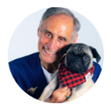How Do You Help a Dog Lose Weight? A Pet Parent’s Guide to Canine Weight Loss. Obesity in dogs is a growing concern that affects millions of pets worldwide. Just like humans, carrying excess weight can lead to serious health problems for dogs, including joint pain, diabetes, heart disease, decreased stamina, and a shortened lifespan. Helping your dog lose weight isn’t about quick fixes or crash diets. It’s about making sustainable, healthy changes that support their long-term wellbeing. If you’re wondering how to help your dog shed those extra pounds safely and effectively, here’s a step-by-step guide to getting started.
1. Recognize the Signs of Canine Obesity
Before beginning a weight loss plan, it’s important to determine if your dog is overweight or obese. A dog at a healthy weight should have a visible waist when viewed from above and a slight abdominal tuck when viewed from the side. You should be able to feel, but not see, the ribs without pressing hard.
Signs of excess weight include:
-
Difficulty walking or playing
-
Labored breathing after mild activity
-
Lack of energy or frequent fatigue
-
Excess fat around the belly, hips, or chest
If you suspect your dog may be overweight, consult your veterinarian for an accurate weight assessment and body condition score.
2. Schedule a Veterinary Checkup
Weight gain can sometimes be linked to underlying medical issues such as hypothyroidism or Cushing’s disease. Before implementing any dietary or activity changes, book a wellness exam with your vet. They will:
-
Rule out any health problems
-
Determine your dog’s ideal target weight
-
Recommend a realistic weight loss goal and timeline
-
Help design a customized weight loss plan
Your veterinarian may suggest switching to a prescription weight loss dog food, or they may recommend gradual portion control with your current food.
3. Measure Meals and Monitor Calories
Portion control is one of the most important factors in helping a dog lose weight. Many pet parents overfeed without realizing it. Start by:
-
Using a measuring cup or kitchen scale for accuracy
-
Feeding your dog based on their ideal weight, not their current weight
-
Splitting their daily food allotment into two or more meals
 Avoid free feeding (leaving food out all day). Instead, feed set meals at consistent times to support metabolism and routine. Count all calories. Including treats.
Avoid free feeding (leaving food out all day). Instead, feed set meals at consistent times to support metabolism and routine. Count all calories. Including treats.
4. Cut Back on High-Calorie Treats
Treats are often the silent contributor to canine weight gain. Those extra snacks throughout the day can add up quickly. Instead of high-fat or processed treats:
-
Offer healthy alternatives like carrots, green beans, or small pieces of apple
-
Break treats into smaller portions
-
Use affection, praise, or play as non-food rewards
Limit treats to no more than 10% of your dog’s total daily caloric intake. If you train with treats frequently, opt for low-calorie options.
5. Choose a Weight Management Dog Food
If your dog is overweight, switching to a specially formulated weight management dog food can help. These diets are:
-
Lower in calories and fat
-
Higher in fiber to help your dog feel full
-
Often enriched with L-carnitine to support fat metabolism
 Work with your vet or canine nutritionist to select a food that supports safe and gradual weight loss. Rapid weight loss can be dangerous, especially for older dogs or those with preexisting conditions.
Work with your vet or canine nutritionist to select a food that supports safe and gradual weight loss. Rapid weight loss can be dangerous, especially for older dogs or those with preexisting conditions.
6. Increase Daily Exercise
Physical activity is essential for helping dogs burn calories and improve their overall health. Tailor your dog’s exercise plan to their current fitness level, breed, and age. Here are some ideas:
-
Start with short daily walks and gradually increase duration and intensity
-
Play games like fetch, tug-of-war, or hide and seek
-
Try swimming, which is easy on the joints and great for overweight dogs
-
Schedule doggy playdates for social interaction and activity
For dogs who haven’t exercised regularly, start slow and build up their endurance over time.
7. Track Progress and Stay Consistent
Weigh your dog every two to four weeks and keep a record of their weight and measurements. Dogs typically lose 1-2% of their body weight per week, so slow and steady wins the race. If your dog isn’t losing weight despite reduced portions and increased activity, it’s time to reassess with your vet.
Consistency is key. Make sure all family members are on the same page with feeding routines, treat limits, and daily walks. Mixed messages can sabotage weight loss efforts.
8. Avoid Table Scraps and People Food
Feeding dogs scraps from the table can be a major contributor to weight gain. Many human foods are calorie-dense, salty, and unsafe for dogs. For example, a single slice of cheese can be equivalent to a burger for a small dog in terms of calorie impact. Instead:
-
Feed only food meant for dogs
-
Encourage guests and family members not to sneak snacks
-
Keep your dog out of the kitchen during meal prep and dining

Did you find this article useful? Would you like 100% free access to more articles like these, and free access to over 5,000 vetted pet care service professionals throughout the United States? Sign up here for a free Petworks account, and take 10% off your first booking, on us!
Consider Enrichment Toys for Mealtime
Interactive toys and slow feeders can help reduce how quickly your dog eats and make mealtime more mentally stimulating. These tools promote portion control while encouraging natural foraging behavior. Puzzle feeders, treat-dispensing balls, and snuffle mats can also increase movement and mental engagement, contributing to healthier habits.
Celebrate Progress (Without Food)
As your dog sheds pounds and starts feeling better, celebrate with non-food rewards. Take them on a new hike, buy them a new toy, or schedule extra snuggle time. These experiences reinforce the bond between you and your pet and create positive associations with their health journey.
Set Them Up for Lifelong Health
Helping your dog lose weight is one of the most loving things you can do for them. A lean dog is a healthy dog. Better equipped to enjoy walks, play, and quality years with you. While it takes time, patience, and teamwork, the benefits of helping your dog reach a healthy weight are immeasurable.
When in doubt, lean on professional support from your veterinarian, a pet nutritionist, or even a certified dog trainer to create a plan that works for your dog’s body and your lifestyle. Your commitment can give your dog the gift of a longer, happier life.
 In 2021, Dr. Marty Goldstein DVM joined the pet care platform Petworks as an advisor in its Animal Nutrition care division. Dr Marty Nature’s Blend is on a mission to help your pets live their healthiest lives possible. Dr. Marty’s pet nutrition expertise and guidance has helped Petworks evolve and become the preeminent animal and pet nutrition consultation service for pet parents in North America.
In 2021, Dr. Marty Goldstein DVM joined the pet care platform Petworks as an advisor in its Animal Nutrition care division. Dr Marty Nature’s Blend is on a mission to help your pets live their healthiest lives possible. Dr. Marty’s pet nutrition expertise and guidance has helped Petworks evolve and become the preeminent animal and pet nutrition consultation service for pet parents in North America.
 In 2022, Blue Buffalo Founder Bill Bishop Jr. joined Petworks as Senior Advisor in our Animal Nutrition Care Division. Bill brings his extensive expertise in pet food innovation and business leadership. His guidance helps Petworks enhance our pet nutrition service offerings, helping to ensure that pet parents throughout the world receive trusted, science-backed nutritional support for their dogs, cats, and animals.
In 2022, Blue Buffalo Founder Bill Bishop Jr. joined Petworks as Senior Advisor in our Animal Nutrition Care Division. Bill brings his extensive expertise in pet food innovation and business leadership. His guidance helps Petworks enhance our pet nutrition service offerings, helping to ensure that pet parents throughout the world receive trusted, science-backed nutritional support for their dogs, cats, and animals.
About The Author
 Petworks Co-Founder Kevin Kinyon is a life-long animal lover who works tirelessly to improve the lives of pets and their parents. Human and animal qualities he values most are integrity, humor, and empathy.
Petworks Co-Founder Kevin Kinyon is a life-long animal lover who works tirelessly to improve the lives of pets and their parents. Human and animal qualities he values most are integrity, humor, and empathy.


